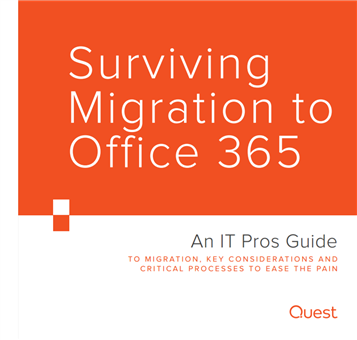Major IT migrations aren’t easy. What’s especially frustrating is that while the decision to move to a new IT platform likely did not fall on the IT administrator’s plate, the responsibility for a flawless rollout does. Such is the case with an Office 365 migration, an increasingly common shift for organizations moving an on-premises Microsoft install or other enterprise messaging platform to the cloud.
Got the directive for a move to Office 365. Now what? Download the Quest eBook: "Surviving Migration to Office 365," for Key Considerations and Best Practices To ensure success and ease the pain of a migration, tight alignment between IT decision makers and the IT team is critical. Alignment should include discussion about scope of the deployment, accountability for staying on track, success measurements and a communication strategy for all those impacted by the migration. But that conversation and a process to set reasonable, achievable expectations for an Office 365 migration can’t really happen until the IT administrators truly understand how complex the migration will be.
To ensure success and ease the pain of a migration, tight alignment between IT decision makers and the IT team is critical. Alignment should include discussion about scope of the deployment, accountability for staying on track, success measurements and a communication strategy for all those impacted by the migration. But that conversation and a process to set reasonable, achievable expectations for an Office 365 migration can’t really happen until the IT administrators truly understand how complex the migration will be.
Enter a pre-migration assessment.
“But won’t a pre-migration assessment take extra time?” says the CIO who wants to check Migrate to Office 365 off his 2017 to-do list. In fact it will and organizations with 500+ employees should anticipate at least 1-2 months for a proper assessment. But, the consequence of not performing an assessment would be far more disruptive. A pre-migration assessment provides the IT team with full visibility into their current IT environment, important information that enables the team to determine:
- What critical data and users accounts should be migrated
- When critical data and users accounts should be migrated
- How to simplify the IT environment to minimize the complexity of the migration
While a comprehensive pre-migration assessment includes several elements, begin with an IT asset inventory. An inventory of the IT environment includes:
- Users accounts (login names, email addresses and delegation relationships)
- Size of user mailboxes
- Offline data, in third-party archives or local PST files
- Client versions and configurations
- Network settings
- File storage locations
- Online meeting and Instant Messaging systems
- Additional third-party applications with workflows integrated into existing systems
With an inventory complete, IT teams can move on to additional steps. Stay tuned for our next blog post that provides a look at other critical assessments.
A pre-migration assessment may be the most critical element of a successful cloud migration. But the IT team’s work doesn’t stop there.


